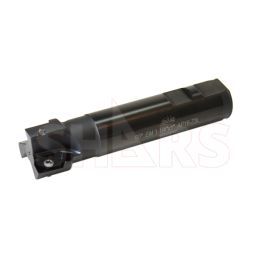Probably looking at this from the wrong approach, and also talking about end mill vs. indexable end mills. The number of flutes is often dictated by the material you are cutting the rigidity of the machine, the speed and feed. Using standard end mills, I find 2 flute produces the most chatter and poor finish. I have a bunch of them, I do not use them for the most part. The exception may be smaller diameters. On aluminum I use 3 flute high helix from 1/4"-3/4", it is critical to do climb milling and also some form of chip evacuation. Air system with light lubrication will give you a far superior cut. On steels I primarily use 4 flute coated end mills from 1/4"-1". If I am using a rougher this are often 5-7 flute in the 1/2-1" range. Th roughers also work well with aluminum, you can remove a lot of material quickly without them fouling. I you are looking for a good all around end mill in the 1/2-1" range, then look ate the Minicut 930P and 930PM, this have a wave pattern cutting edge which gives the chip removal of a rougher with a very smooth finish. These are powdered cobalt metal and hold up very well in a wide range of materials, the polished flutes are more suitable to aluminum. This is my go to end mill in a 3/4" and 7/8" size. I also have 1" 4 flute end mills that I occasionally use but typically use a rougher and then switch to indexable for wider surface cuts/finish.

minicut.com
In order to use a 1" end mill in a R8 spindle you will need to either use an ER40 R8 chuck (which is what I use) or an end mill holder. You loose Z axis travel, and there is greater possibility of deflection. With insert type end mills, you are limited as to depth of cut, and the wall will probably be more uneven as you go deeper. Depends on the holder and inserts used. I stick with conventional end mills in under 1". If I am shouldering or need to remove a lot of material then I use a 2" insert head with 90 degree inserts for steel (mine takes 6 AP inserts). The APxx inserts are pretty standard the size of the insert is probably more a factor of the head design and intended depth of cut. either size is readily available and inexpensive on eBay. Stick with quality insert manufactures such as Iscar, Kennametal, Mitsubishi, etc. The fewer the inserts, typical the the more vibration, more inserts require more Hp. There are a multiple of factors/inserts for insert holders and they are material/work specific. The quality/machining of the holder is important as to the insert heights and finish.
If I were to recommend a smaller indexable end mill than I would go with a 1.00 - 1.25" 3 flute type 1604. The fewer the flutes, the more likely you are to hit the body of the end mill if you feed too quickly w/o enough RPM to clear the the chip for the next cut. So take note of the cutters recommendations. There is also limitations as to the depth of cut due to the shoulder on the end mill. The insert size is a function of the diameter of the indexable cutter, either size is readily available and price would not be much different. The 1604 are much more common on eBay, etc. My indexable cutters use APKT inserts, APMT slightly tighter insert tolerances and more difficult to source at a discounted price. They are equivalent otherwise.
Shars Tool

www.shars.com
The other downside is a 1" or larger end mill needs to be used with a end mill holder so there is a huge stick out below the spindle = more deflection. I would sticking with 3/4" end mills and use indexable in a 90 degree face mill for shouldering. Also look at the Micro100 and a few other brands, I feel it is a lot of money were you would be better off with a conventional end mill for 1" and under. Shar's has some inexpensive indexable end mills. Shar's would be a good choice w/o spending a lot of $$ if you want something in the this size, the 404-2866 is a 1.25" 3 flute 1604 insert with a 1" shank. Probably use a dedicated 1" end mill holder unless you have an ER40 R8 chuck.

www.shars.com
Shars Tool

www.shars.com
Glacern Machine Tools manufacturers CNC Machine Vises, Precision Tool Holders, and Indexable Milling Cutters for vertical and horizontal cnc milling machines.

www.glacern.com
Glacern Machine Tools manufacturers CNC Machine Vises, Precision Tool Holders, and Indexable Milling Cutters for vertical and horizontal cnc milling machines.

www.glacern.com



